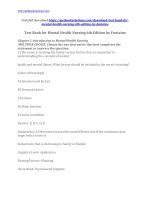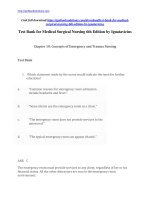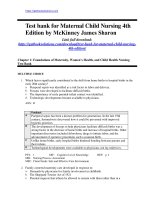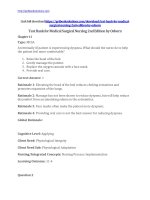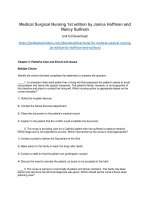Test bank for medical surgical nursing 3rd edition by dewit stromberg and dallred
Bạn đang xem bản rút gọn của tài liệu. Xem và tải ngay bản đầy đủ của tài liệu tại đây (426.13 KB, 20 trang )
Test Bank for Medical Surgical Nursing 3rd edition by deWit
Stromberg and Dallred
Link full download:
/>
Chapter 2: Critical Thinking and the Nursing Process
deWit: Medical-Surgical Nursing: Concepts & Practice, 3rd Edition
MULTIPLE CHOICE
1.Which foundational behavior is necessary for effective critical thinking?
a.
Unshakable beliefs and values
b.
An open attitude
c.
An ability to disregard evidence inconsistent with set goals
d.
An ability to recognize the perfect solution
ANS: B
An open attitude not clouded by unshakable beliefs and values or preset goals allows the application of
critical thinking. Acceptance that there may not be a perfect solution leaves the field open to new ideas.
PTS: 1 DIF: Cognitive Level: Comprehension REF: 16, Box 2-1
OBJ:2 (theory)TOP:Factors Influencing Critical Thinking
KEY: Nursing Process Step: N/A MSC: NCLEX: Health Promotion and Maintenance
2.Which fundamental belief underscores the basis of the nursing process?
a.
Recognition that basic needs must be met by the individual without assistance.
b.
Acknowledgment that patients and families appreciate an efficient health care system that
functions without their input.
c.
A focus on disease control as the most important aspect of patient care.
d.
Recognition that all people have worth and dignity.
ANS: D
The nursing process is based on the belief that all people have worth and dignity. Patient-centered care
that is applied to all aspects of the patient’s health, and is not just disease oriented, is appreciated by
the family and patient. Holistic care approach can support the patient to meet basic needs.
PTS: 1 DIF: Cognitive Level: Comprehension REF: 17
OBJ: 5 (theory) TOP: Basic Beliefs Pertinent to the Nursing Process
KEY:Nursing Process Step: Implementation
MSC:NCLEX: Safe, Effective Care Environment: Coordinated Care
3.The nurse is assessing a new patient who complains of his chest feeling tight. The patient displays a
temperature of 100° F and an oxygen saturation of 89%, and expectorates frothy mucus. Which finding
is an example of subjective data?
a.
Temperature
b.
Oxygen saturation
c.
Frothy mucus
d.
Chest tightness
ANS: D
Subjective data is information given by the patient that cannot be measured otherwise. The other data
are considered objective data. Objective data are pieces of information that can be measured by the
examiner. The nurse should avoid making judgments or conclusions when obtaining data.
PTS: 1 DIF: Cognitive Level: Application REF: 18
OBJ:8 (clinical)TOP:Assessment Data
KEY:Nursing Process Step: Planning
MSC:NCLEX: Safe, Effective Care Environment: Coordinated Care
4.The nurse is caring for a newly admitted patient who is describing his recent symptoms to the nurse.
This scenario is an example of which type of source?
a.
Primary
b.
Objective
c.
Secondary
d.
Complete
ANS: A
The patient is the primary source of information. Objective refers to a type of data obtained by the
nurse that is measured or can be verified through assessment techniques, secondary information is
obtained from relatives or significant others, and information is not necessarily complete when the
patient is the source.
PTS: 1 DIF: Cognitive Level: Application REF: 19
OBJ:8 (clinical)TOP:Sources of Information
KEY:Nursing Process Step: Assessment
MSC:NCLEX: Safe, Effective Care Environment: Coordinated Care
5.The nurse is performing an intake interview on a new resident to the long-term care facility. The nurse
detects the odor of acetone from the patient’s breath. Which term accurately describes this
assessment?
a.
Inspection
b.
Observation
c.
Auscultation
d.
Olfaction
ANS: D
Olfaction is an assessment method of smells. Inspection and observation use the sense of vision.
Auscultation refers to use of the sense of hearing.
PTS: 1 DIF: Cognitive Level: Comprehension REF: 20
OBJ: 9 (clinical) TOP: Olfaction KEY: Nursing Process Step: Assessment
MSC: NCLEX: Health Promotion and Maintenance
6.During a morning assessment, the nurse observes that the patient displays significant edema of both
feet and ankles. Which statement best documents these findings?
a.
Pitting edema present in both feet and ankles
b.
Edema in both feet and ankles approximately 4 mm deep
c.
4 mm pitting edema quickly resolving
d.
Bilateral pitting edema in feet and ankles, 4 mm deep, resolving in 3 seconds ANS: D
Edema should be recorded as to location, depth of pitting, and time for resolution.
PTS: 1 DIF: Cognitive Level: Application REF: 20
OBJ: 9 (theory) TOP: Palpation KEY: Nursing Process Step: Assessment
MSC:NCLEX: Physiological Integrity: Basic Care and Comfort
7.Which technique should the nurse employ to best assess skin turgor?
a.
Examine mucous membranes of the mouth.
b.
Compare limbs for similar color.
c.
Pinch a skinfold on chest to assess for tenting.
d.
Palpate the ankles for evidence of pitting edema.
ANS: C
Skin turgor can be assessed by tenting the skin on the chest and recording the speed at which the “tent”
subsides.
PTS: 1 DIF: Cognitive Level: Comprehension REF: 22
OBJ:9 (clinical)TOP:Practical Assessment
KEY:Nursing Process Step: Assessment
MSC: NCLEX: Health Promotion and Maintenance: Prevention and Early Detection of Disease
8.Which example shows that the nursing student demonstrates compliance with the Health Insurance
Portability and Accountability Act (HIPAA)?
a.
The student uses the patient’s full name only on clinical assignments submitted to the
instructor.
b.
The student uses the facility printer to copy laboratory reports on an assigned patient.
c.
The student shreds any documents that contain identifying patient information before leaving
the clinical facility.
d.
The student asks the patient for permission to copy laboratory and diagnostic reports for
educational purposes.
ANS: C
HIPAA forbids any information used for educational purposes to have any identifying information;
therefore, shredding documents would be appropriate. Full names on documents, printing copies of
chart forms, and asking the patient for permission to copy forms would be violations of HIPAA
regulations.
PTS: 1 DIF: Cognitive Level: Comprehension REF: 26
OBJ: 4 (theory) TOP: HIPAA KEY: Nursing Process Step: Implementation
MSC:NCLEX: Safe, Effective Care Environment: Coordinated Care
9.The diabetic patient who had blood drawn for an HbA1c level says, “I don’t know why they want to
look at my hemoglobin.” Which response is most appropriate for the nurse to make?
a.
“Diabetes increases your risk of bleeding.”
b.
“The HbA1c provides information relative to blood sugar levels for the last 2 to 3 months.”
c.
“Hemoglobin levels and blood sugar levels are closely related.”
d.
“The HbA1c tells if you have type 1 or type 2 diabetes.”
ANS: B
HbA1c evaluates the average blood glucose level for the last 2 to 3 months. By explaining the purpose of
the common laboratory test (HgbA1c) and its relationship to diabetes, the nurse answers the patient’s
question and clearly communicates relevant data.
PTS: 1 DIF: Cognitive Level: Comprehension REF: 25, 27
OBJ:8 (clinical)TOP:Diagnostic Studies
KEY:Nursing Process Step: Implementation
MSC: NCLEX: Health Promotion and Maintenance
10.The nurse is caring for a patient with the problem statement/nursing diagnosis of Risk for Impaired
Skin Integrity Related to Immobility. Which goal/outcome statement best correlates with this diagnosis?
a.
The patient will sit in chair at bedside for 15 minutes after each meal.
b.
The nurse will assist the patient to chair every shift.
c.
The nurse will assess skin and record condition every shift.
d.
The patient will change positions frequently.
ANS: A
The goal/outcome statement is directed at the etiology and should be patient oriented. The statement
should be realistic and measurable and reflect what the patient will do.
PTS: 1 DIF: Cognitive Level: Comprehension REF: 24
OBJ: 11 (clinical) TOP: Goals KEY: Nursing Process Step: Planning
MSC:NCLEX: Physiological Integrity: Basic Care and Comfort
11.The nurse who has recently moved from Louisiana to Texas is uncertain about the LPN/LVN’s role in
applying the nursing process. Which source is most appropriate source for the nurse to consult?
a.
Hospital policies
b.
The Texas State Board of Nursing
c.
Rules and regulations of the Louisiana Nurse Practice Act
d.
The National Association of Practical Nurse Education and Service ANS: B
Each state has different guidelines for areas of care planning, intravenous therapy, teaching, and
delegation. The Texas State Board of Nursing is the most reliable source.
PTS: 1 DIF: Cognitive Level: Comprehension REF: 17
OBJ: 4 (theory) TOP: Nursing Process KEY: Nursing Process Step: N/A
MSC:NCLEX: Safe, Effective Care Environment: Coordinated Care
12.The nurse adds a nursing order to the care plan related to a patient with a problem
statement/nursing diagnosis of altered nutrition/Nutrition: Less Than Body Requirements Related to
Nausea and Vomiting. Which nursing order should the nurse include in the plan of care?
a.
Medicate with an antiemetic before each meal.
b.
Offer crackers and iced drink before each meal.
c.
Change diet to clear liquids.
d.
Give nothing by mouth until nausea subsides.
ANS: B
Offering crackers and iced drinks are within the scope of nursing; the other options would require a
medical order to complete.
PTS: 1 DIF: Cognitive Level: Application REF: 18
OBJ:11 (clinical)TOP:Nursing Orders
KEY:Nursing Process Step: Planning
MSC:NCLEX: Physiological Integrity: Basic Care and Comfort
13.After evaluating the nursing care plan, the nurse finds lack of progress toward the goal. What action
should the nurse take next?
a.
Create a more accessible goal.
b.
Revise the nursing interventions.
c.
Change the problem statement/nursing diagnosis.
d.
Use a new evaluation plan.
ANS: B
When lack of progress to reach the goal is seen on evaluation, the interventions are reviewed and/or
revised.
PTS: 1 DIF: Cognitive Level: Application REF: 26
OBJ: 10 (clinical) TOP: Evaluation KEY: Nursing Process Step: Planning
MSC:NCLEX: Safe, Effective Care Environment: Coordinated Care
14.During an intake interview, the nurse observes the patient grimacing and holding his hand over his
stomach. The patient previously denied having any pain. What action should the nurse take next?
a.
Examine the history closely for etiology of pain.
b.
Ask the patient if he is experiencing abdominal pain.
c.
Record that patient seems to be having abdominal discomfort.
d.
Physically examine the patient’s abdomen.
ANS: B
The nurse should try to resolve any incongruence between body language and verbal responses.
PTS: 1 DIF: Cognitive Level: Application REF: 20, Box 2-5
OBJ:7 (clinical)TOP:Patient Interview
KEY: Nursing Process Step: Assessment MSC: NCLEX: Health Promotion and Maintenance
15.While conducting an admission interview, the nurse questions the patient about pain. The patient
responds, “No. I’m pretty wobbly.” Which action should the nurse take next?
a.
Repeat the question about pain.
b.
Ask the patient to clarify his meaning.
c.
Record that the patient denied pain.
d.
Record that the patient stated he was wobbly.
ANS: B
The nurse should ask for clarification if unsure of what is meant by one of the patient’s responses.
PTS: 1 DIF: Cognitive Level: Application REF: 20, Box 2-5
OBJ:7 (clinical)TOP:Patient Interview
KEY: Nursing Process Step: Assessment MSC: NCLEX: Health Promotion and Maintenance
16.The nurse is caring for a patient with a goal/outcome statement of Patient will sleep for 5 hours
uninterrupted each night. Which nursing intervention should the nurse include?
a.
Medicate with sedative each night.
b.
Offer warm fluids frequently.
c.
Arrange for a large meal at supper.
d.
Discourage daytime napping.
ANS: D
Discouraging daytime napping increases the probability of sleep. Giving medication is a collaborative
intervention as it requires an order. Large meal and large fluid intakes may interrupt sleep.
PTS: 1 DIF: Cognitive Level: Application REF: 25
OBJ:11 (clinical)TOP:Nursing Intervention
KEY:Nursing Process Step: Planning
MSC:NCLEX: Physiological Integrity: Basic Care and Comfort
17.The nursing team is prioritizing the problem statement/nursing diagnoses of an overweight hospital
patient. Which problem statement/nursing diagnosis would be most important for this patient?
a.
Risk for dehydration related to vomiting.
b.
Activity intolerance related to shortness of breath.
c.
Knowledge deficit related to weight reduction diet.
d.
Altered self-image related to excessive weight.
ANS: B
Activity intolerance is the highest priority as it has to do with activities that are essential to life. The
second is Knowledge deficit related to weight reduction diet, followed by Altered self-image related to
excessive weight, and the last is Risk for dehydration related to vomiting.
PTS: 1 DIF: Cognitive Level: Analysis REF: 23
OBJ:11 (clinical)TOP:Setting Priorities
KEY:Nursing Process Step: Planning
MSC:NCLEX: Physiological Integrity: Basic Care and Comfort
18.The nurse is explaining the components of a complete problem statement/nursing diagnosis. In
addition to the NANDA stem and etiology, which other component should the diagnosis include?
a.
A time reference for meeting the need
b.
A designation of what the patient should do
c.
Signs and symptoms of the problem assessed
d.
A specifically worded medical diagnosis
ANS: C
A complete problem statement/nursing diagnosis must have a NANDA stem, etiology, and signs and
symptoms (etiology) of the problem.
PTS: 1 DIF: Cognitive Level: Knowledge REF: 23
OBJ:4 (theory)TOP:Nursing Diagnosis
KEY: Nursing Process Step: Planning MSC: NCLEX: Health Promotion and Maintenance
19.Which statement explains the reason for inclusion of potential problems in the nursing care plan?
a.
To alert nursing staff to prevent potential complications.
b.
To remind the family of potential problems.
c.
To broaden the assessment of the caregiver.
d.
To educate the patient to aspects of her health.
ANS: A
Addressing potential problems prevents complications by early action rather than waiting for a problem
to materialize.
PTS: 1 DIF: Cognitive Level: Comprehension REF: 23
OBJ:7 (clinical)TOP:Potential Health Problems
KEY: Nursing Process Step: Planning MSC: NCLEX: Health Promotion and Maintenance
20.The nurse is completing the medication reconciliation form for a patient. Which information is most
important for the nurse to include?
a.
The patient reports taking Ginkgo biloba daily for the last 6 months.
b.
The patient reports having high hematocrit levels during his last hospital stay.
c.
The patient reports he has been diabetic for 10 years.
d.
The patient reports having a recent infection.
ANS: A
As part of the medication reconciliation form, all home medications (including herbal preparations like
Gingko biloba) are listed and reviewed by the provider, pharmacist, and nurses. The information
gathered during the completion of this form may impact care that the patient will receive. Abnormal lab
work and history of chronic or acute illnesses are important components of the patient’s history but
should not be part of the medication reconciliation form.
PTS: 1 DIF: Cognitive Level: Application REF: 20
OBJ:7 (clinical)TOP:Alternative Medicine
KEY:Nursing Process Step: Assessment
MSC:NCLEX: Physiological Integrity: Reduction of Risk Potential
21.The LPN/LVN adheres to facility policy regarding core measures by performing which interventions
during patient care?
a.
Administering the ordered amount of insulin to a patient with type 1 diabetes.
b.
Performing a thorough patient assessment upon admission to the health care facility.
c.
Documenting accurately and at appropriate intervals in the patient’s record.
d.
Providing patient teaching regarding proper diet for the patient diagnosed with renal failure.
ANS: A
Core measures are interventions that are based on scientifically researched, evidence-based standards
of care, and are used to treat the majority of patients with a specific illness that often develops
complications. Insulin administration for diabetics is evidence-based researched practice. The remaining
options are good practice but are not considered core measures.
PTS: 1 DIF: Cognitive Level: Analysis REF: 25
OBJ:4 (theory)TOP:Core Measures
KEY:Nursing Process Step: Implementation
MSC:NCLEX: Safe, Effective Care Environment: Management of Care
22.The nurse is caring for a patient with pneumonia who complains of shortness of breath. Further
assessment reveals an oxygen saturation of 89% on room air, 28 respirations/min with bilateral crackles
in lung bases, blood pressure of 160/94, and a pulse rate of 102 beats/min. Which nursing diagnosis is
priority for this patient?
a.
Activity Intolerance
b.
Impaired Gas Exchange
c.
Ineffective Cardiopulmonary Tissue Perfusion
d.
Self-Care Deficit: Bathing and Hygiene
ANS: B
While all nursing diagnoses may apply to this patient, impaired gas exchange is the highest priority
because this is the underlying problem for the other nursing diagnoses, as well as physiologically the
highest priority.
PTS: 1 DIF: Cognitive Level: Analysis REF: 23
OBJ:11 (clinical)TOP:Nursing Diagnosis
KEY:Nursing Process Step: Planning
MSC:NCLEX: Safe, Effective Care Environment: Management of Care
MULTIPLE RESPONSE
23.The nurse explains to the nursing student that the application of critical thinking to patient care
involves which factor(s)? (Select all that apply.)
a.
Identification of a patient problem
b.
Setting priorities
c.
Concentrating on the patient rather than family needs
d.
Use of logic and intuition
e.
Expansion of thought beyond the obvious
ANS: A, B, D, E
Critical thinking as applied to nursing care requires setting priorities of patient problems and needs by
using logic and intuition. Inclusion of the family in the care makes the approach family oriented. Critical
thinking should go beyond the obvious.
PTS: 1 DIF: Cognitive Level: Comprehension REF: 15
OBJ:7 (clinical)TOP:Critical Thinking
KEY:Nursing Process Step: Implementation
MSC:NCLEX: Safe, Effective Care Environment: Coordinated Care
24.Which statement(s) demonstrates application of the nursing process? (Select all that apply.)
a.
Performing a head-to-toe assessment.
b.
Updating the patient care plan on a weekly basis.
c.
Evaluating if patient goals have been met.
d.
Determining if nursing interventions need to be changed based on lack of patient progress
toward meeting goals.
e.
Ensuring that all personnel caring for the patient are implementing the care plan and working
toward the same goal.
ANS: A, C, D, E
The nursing care plan should be updated as necessary, not just on a weekly basis. Concepts of the
nursing process are demonstrated by performing orderly, logical head-to-toe assessments, as well as
ongoing evaluation of patient goals and interventions to meet those goals.
PTS: 1 DIF: Cognitive Level: Comprehension REF: 17
OBJ:8 (clinical)TOP:Nursing Process
KEY:Nursing Process Step: Implementation
MSC:NCLEX: Safe, Effective Care Environment: Coordinated Care
25.Which example(s) demonstrate patient care that reflects knowledge of the National Patient Safety
Goals? (Select all that apply.)
a.
Identifying the patient prior to medication administration by asking the patient to state his or
her name.
b.
Reporting any sentinel event to the facility’s quality assurance team.
c.
Assessing the patient’s heartrate prior to administration of digoxin.
d.
Performing hand hygiene prior to performing a patient assessment.
e.
Documenting the appropriate time of medication administration. ANS: C, D, E
Assessing the patient’s heart rate prior to administration of digoxin demonstrates knowledge of
medication actions and prevention of adverse effects; hand hygiene is required before any patient care,
including assessment; and documentation of the time of medication administration is necessary to
prevent medication errors. To meet National Patient Safety Goals, the nurse must use at least two
methods of patient identification prior to medication administration. Reporting a sentinel event is
required but demonstrates that National Patient Safety Goals were not met.
PTS: 1 DIF: Cognitive Level: Application REF: 4, 23
OBJ:4 (theory)TOP:National Patient Safety Goals
KEY:Nursing Process Step: Implementation
MSC: NCLEX: Safe, Effective Care Environment: Safety and Infection Control
COMPLETION
26.The nursing student demonstrates knowledge of the proper use of the ___________ when
determining that it is safe to administer meperidine (Demerol) and promethazine (Phenergan) together.
ANS:
Medication Reconciliation Form
The Medication Reconciliation Form tracks all medications the patient is taking as prescribed by
different physicians and can identify overdoses or drugs that are not compatible.
PTS: 1 DIF: Cognitive Level: Application REF: 20
OBJ:8 (clinical)TOP:Medication Reconciliation Form
KEY:Nursing Process Step: Implementation
MSC:NCLEX: Safe, Effective Care Environment: Coordinated Care
27.Shortness of breath due to emphysema would be a major component of the _________ care plan.
ANS:
interdisciplinary
An interdisciplinary care plan involves all members of the health care team and is based on the medical
diagnosis rather than a problem statement/nursing diagnosis.
PTS: 1 DIF: Cognitive Level: Application REF: 26
OBJ:8 (clinical)TOP:Interdisciplinary Care Plan
KEY: Nursing Process Step: Planning MSC: NCLEX: Health Promotion and Maintenance
MATCHING
Place the steps of the nursing process in their proper sequence.
a.
Evaluation
b.
Assessment
c.
Implementation
d.
Planning
e.
Problem statement/nursing diagnosis
28.Step 1
29.Step 2
30.Step 3
31.Step 4
32.Step 5
28.ANS:BPTS:1DIF:Cognitive Level: Comprehension
REF: 17 OBJ: 4 (theory) TOP: Applying the Nursing Process
KEY: Nursing Process Step: Planning MSC: NCLEX: Health Promotion and Maintenance
29.ANS:EPTS:1DIF:Cognitive Level: Comprehension
REF: 17 OBJ: 4 (theory) TOP: Applying the Nursing Process
KEY: Nursing Process Step: Planning MSC: NCLEX: Health Promotion and Maintenance
30.ANS:DPTS:1DIF:Cognitive Level: Comprehension
REF: 17 OBJ: 4 (theory) TOP: Applying the Nursing Process
KEY: Nursing Process Step: Planning MSC: NCLEX: Health Promotion and Maintenance
31.ANS:CPTS:1DIF:Cognitive Level: Comprehension
REF: 17 OBJ: 4 (theory) TOP: Applying the Nursing Process
KEY: Nursing Process Step: Planning MSC: NCLEX: Health Promotion and Maintenance
32.ANS:APTS:1DIF:Cognitive Level: Comprehension
REF: 17 OBJ: 4 (theory) TOP: Applying the Nursing Process
KEY: Nursing Process Step: Planning MSC: NCLEX: Health Promotion and Maintenance



